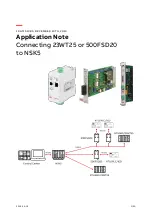
KA-NODE
26
KA-NODE Commands for Remote Use
When accessed by radio, the KA-NODE has several commands which may be given to it. These
commands are listed here for reference, with a description of each command. In these descrip-
tions, the UPPER case characters of the command are requires. LOWER case characters are option-
al. Those item listed within [ ] are optional and if used the UPPER/LOWER case convention listed
above applies.
ABORT
This command will abort a KA-NODE Connect or XCONNECT request if it is the first data sent after
the request. It must be spelled out entirely.
B
ye
This command will cause the KA-NODE to initiate a disconnect.
C
onnect
callsign
This command will cause the node to issue a connect request to
callsign
in the usual AX.25 mode.
If the connect is successful, a link will be made to the next node or end-user station.
H
elp
This command causes the KA-NODE to send a brief help list, showing all commands available, with
the options an a short description of each command.
J
heard [Short | Long]
This command will cause the KA-NODE to transmit its TNC MHEARD log. The returned list (without
the short or long option) will look like this:
(KAM)
(KPC-4)
LAWKAN/H* 01/09/88 08:25:15
LAWKAN/1* 01/09/88 08:25:15
N66046/V 01/10/88 00:03:10
N66046/2 01/10/88 00:03:10
WK5M-3/H 01/10/88 00:03:19
WK5M-3/1 01/10/88 00:03:19
WD0EMR/V 01/10/88 00:04:15
WD0EMR/V 01/10/88 00:04:15
(KPC-1, 2 or 2400)
LAWKAN* 01/09/88 08:25:15
N66046 01/10/88 00:03:10
WK5M-3 01/10/88 00:03:19
WD0EMR 01/10/88 00:04:15
The left column indicates the callsign (and SSID if appropriate) of a station heard. The number fol-
lowing the slant bar (/) shows the port on which the station was heard, if both ports are active.
The asterisk indicates the station was heard via a digipeater. The center and right columns indicate
date and time the station was last heard. In both cases, the last call on the list will probably your
call. The above JHEARD lists show WD0EMR connecting to the KA-NODE and requesting the nodes
JHEARD log.
The short (JHEARD S) version of this command would produce the following list:
(KAM)
(KPC-4)
(KPC-1, 2 or 2400)
LAWKAN/H*
LAWKAN/1*
LAWKAN*
N66046/V
N66046/2
N66046
WK5M-3/H
WK5M-3/1
WK5M-3
WD0EMR/V
WD0EMR/2
WD0EMR
















































